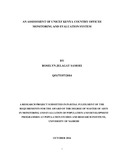An assessment of unicef kenya country officee monitoring and evaluation system

View/
Date
2016-10Author
Jelagat, Roselyn S
Type
ThesisLanguage
enMetadata
Show full item recordAbstract
The overall objective of the study was to assess the UNICEF KCO M&E system and more specifically the assessment was aimed at establishing whether the UNICEF KCO M&E system meets the established standards for an M&E system. The study also aimed to identify strengths and gaps of UNICEF KCO M&E system. The study adopted approaches used for M&E system assessment previously done by organizations such as World Bank, UNAIDS, The Global Fund and FHI 360.
The assessment employed cross sectoral research design which allowed for description of the current UNICEF KCO M&E system and helped to establish strengths and gaps which were fundamental to the realization of research objectives.
The target population for this study was the UNICEF KCO M&E unit, Monitoring and Evaluation Specialists and Officers, Programme Officers, as well as the Chief of Sections. The sample size of the study was 30, the size was purposively sampled from the programme staff who are responsible for M&E work in their respective sections. This method of sampling was appropriate for the study in order to have informed responses to the questionnaire that was administered.
Data was collected through a questionnaire that focused on the assessment of the 12 components of an M&E system. Each of the 12 components was analyzed independently based on the performance of their respective elements identified and an average of each obtained to determine the overall performance of the M&E system. The results of the study showed that the UNICEF KCO M&E system had an average score of 72 percent in all the 12 components the lowest score being 54 percent and the highest score being 89 percent. This a good indication that the system is meeting the established standards for a functional M&E system.
The assessment identified key strengths of the UNICEF KCO M&E system in the following components: Routine programme monitoring, Surveys and Surveillance, Supervision and Data auditing, Research and Evaluation. However, the following components presented opportunities for strengthening; Organizational structure, Human Resource for M&E and M&E partnerships.
xii
Key recommendations were also made for the organization to consider for implementation to further strengthen its M&E system.
The recommendations were based on the poor scoring of respective performance indicators. Organizational structure; Organization to consider budgeting and hiring of M&E staff in each field office so as to foster the M&E agenda in the field offices.
Human Capacity in M&E; The study also recommended periodic assessment of the required skill set for M&E staff. This is important since programmes are dynamic and need to be abreast with the changing needs and environment. The organization should partner with more colleges and universities to build capacities through curriculum development as well as strengthen coordination of capacity building activities so as to avoid duplication of efforts.
M&E partnership; Based on the results obtained the study recommended that an inventory of M&E stakeholders should be established and periodically updated and monitored so that there is better coordination and sharing of information among all the stakeholders. Lastly, the study recommended that the organization should develop a routine communication channel to facilitate exchange of information among stakeholders.
Publisher
University of Nairobi
Subject
Monitoring and Evaluation SystemRights
Attribution-NonCommercial-NoDerivs 3.0 United StatesUsage Rights
http://creativecommons.org/licenses/by-nc-nd/3.0/us/Collections
- Faculty of Education (FEd) [6022]
The following license files are associated with this item:

